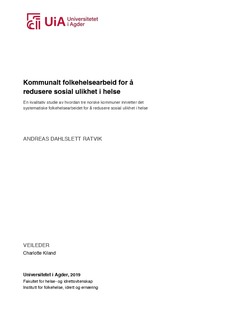| dc.contributor.author | Ratvik, Andreas Dahlslett | |
| dc.date.accessioned | 2019-11-13T12:11:42Z | |
| dc.date.available | 2019-11-13T12:11:42Z | |
| dc.date.issued | 2019 | |
| dc.identifier.uri | http://hdl.handle.net/11250/2628223 | |
| dc.description | Master's Thesis Public Health Science ME516 - University of Agder 2019 | nb_NO |
| dc.description.abstract | Background and aim: The purpose of this project was to study how municipalitieswork tooreducesocial inequalitiesin the local community.Studies have indicated that there exist a multitude of solutionsin how municipalities address thistopic.The last couple of years studies have indicated that an increasingnumberofmunicipalitiesaddress social determinants of health, compared to traditional lifestylessolutionsas nutrition, physical activityand drugs.A variety of studies have also indicated thatmunicipal structure, capacityand collaboration with external actors affects inwhat degree municipalities implement a systematic public health work and prioritize living conditions and the social gradient.Method: This study was based on a qualitative design. The method for obtaining data was qualitative research interviews analyzed with a thematic content analysis. A strategic selection was made of 9informants from threemunicipalities.Results:Thefindings indicate that the local authorities execute public health work in different ways.In two of the threemunicipalities where therehasbeen a systematic work on public health in aftermathofthePublic Health Act, the scope of cooperation with external actors isgreater and several measures are aimed at both universal and selective groups. In the third municipality, where a systematic public health work has not yet been developed, a stronger individual approach is emphasized, and then throughmeasures particularly oriented towards outdoor life and the local environment. The municipalities' systematic and long-term public health work is challenged by a large task force in the municipalities, where restrictions on resources, in particular competence, are emphasized as an explanation for the fact that public health work is to some extent down-prioritized and delayed.Conclusion: The municipalitiesare moving in the direction of increasingly systematic and knowledge-based public health work, but to varying degrees. Having asystematic public health work, HiAP, collaboration with external actors seems to be associated with a greater degreeof measures against the living conditionsand the social gradient. Keywords: Public Health Work, Public HealthAct, Social Inequalities in Health, Social Determinants of Health, Municipal Organization | nb_NO |
| dc.language.iso | nob | nb_NO |
| dc.publisher | Universitetet i Agder ; University of Agder | nb_NO |
| dc.rights | Attribution-NonCommercial-NoDerivatives 4.0 Internasjonal | * |
| dc.rights.uri | http://creativecommons.org/licenses/by-nc-nd/4.0/deed.no | * |
| dc.subject | ME516 | nb_NO |
| dc.subject | Folkehelsearbeid | nb_NO |
| dc.subject | Folkehelseloven | nb_NO |
| dc.subject | Sosiale Helseforskjeller | nb_NO |
| dc.subject | Sosiale Helsedeterminanter | nb_NO |
| dc.subject | Kommunal Organisering | nb_NO |
| dc.subject | Public Health Work | nb_NO |
| dc.subject | Public Health Act | nb_NO |
| dc.subject | Social Inequalities in Health | nb_NO |
| dc.subject | Social Determinants of Health | nb_NO |
| dc.subject | Municipal Organization | nb_NO |
| dc.title | Kommunalt folkehelsearbeid for å redusere sosial ulikhet i helse : En kvalitativ studie av hvordan tre norske kommuner innretter det systematiske folkehelsearbeidet for å redusere sosial ulikhet i helse | nb_NO |
| dc.type | Master thesis | nb_NO |
| dc.subject.nsi | VDP::Medisinske Fag: 700::Helsefag: 800::Samfunnsmedisin, sosialmedisin: 801 | nb_NO |
| dc.source.pagenumber | 105 s. | nb_NO |

